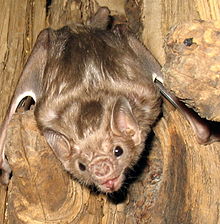- White-winged Vampire Bat
-
White-winged Vampire Bat 
Diaemus youngi Conservation status Scientific classification Kingdom: Animalia Phylum: Chordata Class: Mammalia Order: Chiroptera Family: Phyllostomidae Subfamily: Desmodontinae Genus: Diaemus
Miller, 1906Species: D. youngi Binomial name Diaemus youngi
Jentink, 1893The White-winged Vampire Bat (Diaemus youngi) is a species of vampire bat. It is the only member of the genus Diaemus. It is found from Mexico to southern Argentina and is present on the islands of Trinidad and Isla Margarita. In Trinidad up to 30 Diaemus were found in a hollow immortelle tree and one was found in a well-lit cave along with Desmodus rotundus and Saccopteryx bilineata. Flying individuals are easily identified by their white wing tips.[1]
They seem to prefer the blood of birds to that of mammals and usually feed by hanging on the underside of a branch. Not surprisingly, they do not perform the flight-initiating jumps that characterize the common vampire bat, Desmodus rotundus. And although not as agile on the ground as the common vampire bat, they are quite proficient at climbing branches. White-winged vampires are much more docile than common vampire bats and are also extremely vocal in the audible range.
They have two large oral glands:
- ". . . which can only be seen when the bat's mouth is opened and the glands brought forward like two small cannons. With open mouth, the bat will suddenly make an explosive, hissing sound followed by a foul smelling odour which seems to come from these glands. The use of the glands is not known." [2]
- "The bat opens its mouth when disturbed, bringing to the corners of its mouth two cup-shaped glands, each 2 to 3 mm in diameter, nearly filling the mouth. When necessary the glands can be directed forward, and with a noisy "psst" may emit a fine jet of liquid which has a powerful mustelid, skunk-like odor offensive to many people. Extractions tests made in Trinidad indicated the presence of several common amino acids and an unidentified sulphur-containing compound."[3]
This bat has been found to carry rabies in Trinidad.[4]
Footnotes
- ^ A.M. Greenhall and U. Schmidt, editors. 1988. Natural History of Vampire Bats, CRC Press, Boca Raton, Florida. ISBN 0849367506; ISBN 978-0849367502, p. 122
- ^ Greenhall, Arthur M. 1961. Bats in Agriculture. A Ministry of Agriculture Publication. Trinidad and Tobago, p. 10.
- ^ A.M. Greenhall and U. Schmidt, editors. 1988. Natural History of Vampire Bats, CRC Press, Boca Raton, Florida. ISBN 0849367506; ISBN 978-0849367502, p. 125.
- ^ Greenhall (1961), p. 10.
References
- Carter G, B Fenton, P Faure. 2009. "White-winged vampire bats exchange contact calls." Canadian Journal of Zoology. 87, 604-608. doi: 10.1139/Z09-051. PDF
- Carter G, M Skowronski, P Faure, B Fenton. 2008. "Antiphonal calling allows individual discrimination in white-winged vampire bats." Animal Behaviour. 76, 1343-1355 doi:10.1016/j.anbehav.2008.04.023. PDF
- Greenhall, Arthur M. 1961. Bats in Agriculture. A Ministry of Agriculture Publication. Trinidad and Tobago.
- A.M. Greenhall and U. Schmidt, editors. 1988. Natural History of Vampire Bats, CRC Press, Boca Raton, Florida. ISBN 0849367506; ISBN 978-0849367502
- "Diaemus youngi". IUCN Red List of Threatened Species. Version 2010.2. International Union for Conservation of Nature. 2008. http://www.iucnredlist.org/apps/redlist/details/6520. Retrieved 17 July 2010.
- Mammalian Species Account
External links
- Vampires: The Real Story - about the vampire bat.
- Bat Conservation International - A website devoted to the education, conservation and study of bats.
- Graduate student research on white-winged vampire bats
Categories:- IUCN Red List least concern species
- Bats of South America
- Phyllostomidae
- Mammals of Costa Rica
Wikimedia Foundation. 2010.
Look at other dictionaries:
white-winged vampire bat — baltasparnis vampyras statusas T sritis zoologija | vardynas taksono rangas rūšis atitikmenys: lot. Diaemus youngi angl. spotted vampire bat; white winged vampire; white winged vampire bat vok. Weißschwingen Vampir rus. белокрылый вампир pranc.… … Žinduolių pavadinimų žodynas
white-winged vampire — baltasparnis vampyras statusas T sritis zoologija | vardynas taksono rangas rūšis atitikmenys: lot. Diaemus youngi angl. spotted vampire bat; white winged vampire; white winged vampire bat vok. Weißschwingen Vampir rus. белокрылый вампир pranc.… … Žinduolių pavadinimų žodynas
White-winged — may refer to:In ornithology:* White winged Chough, one of only two surviving members of the Australian mud nest builders family, Corcoracidae * White winged Dove, dove whose native range extends from the south western USA through Mexico and the… … Wikipedia
Vampire bat — For the 1933 movie, see The Vampire Bat. Vampire bats Common Vampire Bat, Desmodus rotundus Scientific classification Kingdom … Wikipedia
vampire bat — 1. any of several New World tropical bats of the genera Desmodus, Diphylla, and Diaemus, the size of a small mouse, feeding on small amounts of blood obtained from resting mammals and birds by means of a shallow cut made with specialized incisor… … Universalium
Hairy-legged Vampire Bat — Conservation status Least Concern ( … Wikipedia
Common Vampire Bat — Conservation status Least Concern (IUCN 3.1) … Wikipedia
spotted vampire bat — baltasparnis vampyras statusas T sritis zoologija | vardynas taksono rangas rūšis atitikmenys: lot. Diaemus youngi angl. spotted vampire bat; white winged vampire; white winged vampire bat vok. Weißschwingen Vampir rus. белокрылый вампир pranc.… … Žinduolių pavadinimų žodynas
White-bellied Big-eared Bat — Conservation status Least Concern (IUCN 3.1) Scientific classification … Wikipedia
Bat — For other uses, see Bat (disambiguation). Bats Temporal range: 52–0 Ma … Wikipedia

